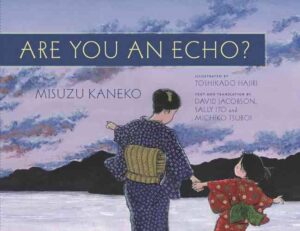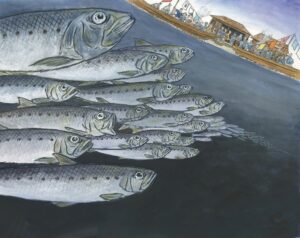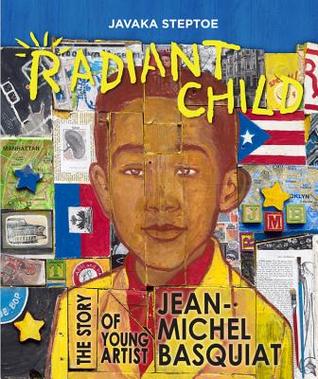 Are You an Echo? The Lost Poetry of Misuzu Kaneko
Are You an Echo? The Lost Poetry of Misuzu Kaneko
Narrative and Translation by David Jacobson, Sally Ito, and Michiko Tsuboi
Illustrated by Toshikado Hajiri
Chin Music Press
$19.50
ISBN: 9781634059626
Ages 5 and up
On shelves now
Recently I was at a conference celebrating the creators of different kinds of children’s books. During one of the panel discussions an author of a picture book biography of Fannie Lou Hamer said that part of the mission of children’s book authors is to break down “the canonical boundaries of biography”. I knew what she meant. A cursory glance at any school library or public library’s children’s room will show that most biographies go to pretty familiar names. It’s easy to forget how much we need biographies of interesting, obscure people who have done great things. Fortunately, at this conference, I had an ace up my sleeve. I knew perfectly well that one such book has just been published here in the States and it’s a game changer. Are You an Echo? The Lost Poetry of Misuzu Kaneko isn’t your typical dry as dust retelling of a life. It crackles with energy, mystery, tragedy, and, ultimately, redemption. This book doesn’t just break down the boundaries of biography. It breaks down the boundaries placed on children’s poetry, art, and translation too. Smarter and more beautiful than it has any right to be, this book challenges a variety of different biography/poetry conventions. The fact that it’s fun to read as well is just gravy.
Part biography, part poetry collection, and part history, Are You an Echo? introduces readers to the life and work of celebrated Japanese poet Misuzu Kaneko. One day a man by the name of Setsuo Yazaki stumbled upon a poem called “Big Catch”. The poet’s seemingly effortless ability to empathize with the plight of fish inspired him to look into her other works. The problem? The only known book of her poems out there was caught in the conflagration following the firebombing of Tokyo during World War II. Still, Setsuo was determined and after sixteen years he located the poet’s younger brother who had her diaries, containing 512 of Misuzu’s poems. From this, Setsuo was able to piece together her life. Born in 1902, Misuzu Kaneko grew up in Senzaki in western Japan. She stayed in school at her mother’s insistence and worked in her mother’s bookstore. For fun she submitted some of her poems to a monthly magazine and shockingly every magazine she submitted them to accepted them. Yet all was not well for Misuzu. She had married poorly, contracted a disease from her unfaithful husband that caused her pain, and he had forced her to stop writing as well. Worst of all, when she threatened to leave he told her that their daughter’s custody would fall to him. Unable to see a way out of her problem, she ended her life at twenty-six, leaving her child in the care of her mother. Years passed, and the tsunami of 2011 took place. Misuzu’s poem “Are You an Echo?” was aired alongside public service announcements and it touched millions of people. Suddenly, Misuzu was the most famous children’s poet of Japan, giving people hope when they needed it. She will never be forgotten again. The book is spotted with ten poems throughout Misuzu’s story, and fifteen additional poems at the end.
 There’s been a lot of talk in the children’s literature sphere about the role of picture book biographies. More specifically, what’s their purpose? Are they there simply to inform and delight or do they need to actually attempt to encapsulate the great moments in a person’s life, warts and all? If a picture book bio only selects a single moment out of someone’s life as a kind of example, can you still call it a biography? If you make up dialogue and imagine what might have happened in one scene or another, do those fictional elements keep it from the “Biography” section of your library or bookstore, or is there a place out there for fictionalized bios? These questions are new ones, just as the very existence of picture book biographies, in as great a quantity as we’re seeing them, is also new. One of the takeaways I’ve gotten from these conversations is that it is possible to tackle difficult subjects in a picture book bio, but it must be done naturally and for a good reason. So a story like Gary Golio’s Spirit Seeker can discuss John Coltrane’s drug abuse, as long as it serves the story and the character’s growth. On the flip side, Javaka Steptoe’s Radiant Child, a biography of Basquiat, makes the choice of discussing the artist’s mother’s fight with depression and mental illness, but eschews any mention of his own suicide.
There’s been a lot of talk in the children’s literature sphere about the role of picture book biographies. More specifically, what’s their purpose? Are they there simply to inform and delight or do they need to actually attempt to encapsulate the great moments in a person’s life, warts and all? If a picture book bio only selects a single moment out of someone’s life as a kind of example, can you still call it a biography? If you make up dialogue and imagine what might have happened in one scene or another, do those fictional elements keep it from the “Biography” section of your library or bookstore, or is there a place out there for fictionalized bios? These questions are new ones, just as the very existence of picture book biographies, in as great a quantity as we’re seeing them, is also new. One of the takeaways I’ve gotten from these conversations is that it is possible to tackle difficult subjects in a picture book bio, but it must be done naturally and for a good reason. So a story like Gary Golio’s Spirit Seeker can discuss John Coltrane’s drug abuse, as long as it serves the story and the character’s growth. On the flip side, Javaka Steptoe’s Radiant Child, a biography of Basquiat, makes the choice of discussing the artist’s mother’s fight with depression and mental illness, but eschews any mention of his own suicide.
Are You An Echo? is an interesting book to mention alongside these two other biographies because the story is partly about Misuzu Kaneko’s life, partly about how she was discovered as a poet, and partly a highlight of her poetry. But what author David Jacobson has opted to do here is tell the full story of her life. As such, this is one of the rare picture book bios I’ve seen to talk about suicide, and probably the only book of its kind I’ve ever seen to make even a passing reference to STDs. Both issues informed Kaneko’s life, depression, feelings of helplessness, and they contribute to her story. The STD is presented obliquely so that parents can choose or not choose to explain it to kids if they like. The suicide is less avoidable, so it’s told in a matter-of-fact manner that I really appreciated. Euphemisms, for the most part, are avoided. The text reads, “She was weak from illness and determined not to let her husband take their child. So she decided to end her life. She was only twenty-six years old.” That’s bleak but it tells you what you need to know and is honest to its subject.
 But let’s just back up a second and acknowledge that this isn’t actually a picture book biography in the strictest sense of the term. Truthfully, this book is rife, RIFE, with poetry. As it turns out, it was the editorial decision to couple moments in Misuzu’s life with pertinent poems that gave the book its original feel. I’ve been wracking my brain, trying to come up with a picture book biography of a poet that has done anything similar. I know one must exist out there, but I was hard pressed to think of it. Maybe it’s done so rarely because the publishers are afraid of where the book might end up. Do you catalog this book as poetry or as biography? Heck, you could catalog it in the Japanese history section and still be right on in your assessment. It’s possible that a book that melds so many genres together could only have been published in the 21st century, when the influx of graphic inspired children’s literature has promulgated. Whatever the case, reading this book you’re struck with the strong conviction that the book is as good as it is precisely because of this melding of genres. To give up this aspect of the book would be to weaken it.
But let’s just back up a second and acknowledge that this isn’t actually a picture book biography in the strictest sense of the term. Truthfully, this book is rife, RIFE, with poetry. As it turns out, it was the editorial decision to couple moments in Misuzu’s life with pertinent poems that gave the book its original feel. I’ve been wracking my brain, trying to come up with a picture book biography of a poet that has done anything similar. I know one must exist out there, but I was hard pressed to think of it. Maybe it’s done so rarely because the publishers are afraid of where the book might end up. Do you catalog this book as poetry or as biography? Heck, you could catalog it in the Japanese history section and still be right on in your assessment. It’s possible that a book that melds so many genres together could only have been published in the 21st century, when the influx of graphic inspired children’s literature has promulgated. Whatever the case, reading this book you’re struck with the strong conviction that the book is as good as it is precisely because of this melding of genres. To give up this aspect of the book would be to weaken it.
Right off the bat I was impressed by the choice of poems. The first one you encounter is called “Big Catch” and it tells about a village that has caught a great number of fish. The poem ends by saying, “On the beach, it’s like a festival / but in the sea they will hold funerals / for the tens of thousands dead.” The researcher Setsuo Yazaki was impressed by the poet’s empathy for the fish, and that empathy is repeated again and again in her poems. “Big Catch” is actually one of her bleaker works. Generally speaking, the poems look at the world through childlike eyes. “Wonder” contemplates small mysteries, in “Beautiful Town” the subject realizes that a memory isn’t from life but from a picture in a borrowed book, and “Snow Pile” contemplates how the snow on the bottom, the snow on the top, and the snow in the middle of a pile must feel when they’re all pressed together. The temptation would be to call Kaneko the Japanese Emily Dickenson, owing to the nature of the discovery of her poems posthumously, but that’s unfair to both Kaneko and Dickenson. Kenko’s poems are remarkable not just because of their original empathy, but also because they are singularly childlike. A kid would get a kick out of reading these poems. That’s no mean feat.
 Mind you, we’re dealing with a translation here. And considering how beautifully these poems read, you might want a note from the translators talking about their process. You can imagine, then, how thrilled I was to find a half-page’s worth of a “Translators’ Note” explaining aspects of the work here that never would have occurred to me in a million years. The most interesting problem came down to culture. As Sally Ito and Michiko Tsuboi write, “In Japanese, girls have a particular way of speaking that is affectionate and endearing . . . However, English is limited in its capacity to convey Misuzu’s subtle feminine sensibility and the elegant nuances of her classical allusions. We therefore had to skillfully work our way through both languages, often producing several versions of a poem by discussing them on Skype and through extensive emails – Michiko from Japan, Sally from China – to arrive at the best possible translations in English.” It makes a reader really sit back and admire the sheer levels of dedication and hard work that go into a book of this sort. If you read this book and find that the poems strike you as singularly interesting and unique, you may now have to credit these dedicated translators as greatly as you do the original subject herself. We owe them a lot.
Mind you, we’re dealing with a translation here. And considering how beautifully these poems read, you might want a note from the translators talking about their process. You can imagine, then, how thrilled I was to find a half-page’s worth of a “Translators’ Note” explaining aspects of the work here that never would have occurred to me in a million years. The most interesting problem came down to culture. As Sally Ito and Michiko Tsuboi write, “In Japanese, girls have a particular way of speaking that is affectionate and endearing . . . However, English is limited in its capacity to convey Misuzu’s subtle feminine sensibility and the elegant nuances of her classical allusions. We therefore had to skillfully work our way through both languages, often producing several versions of a poem by discussing them on Skype and through extensive emails – Michiko from Japan, Sally from China – to arrive at the best possible translations in English.” It makes a reader really sit back and admire the sheer levels of dedication and hard work that go into a book of this sort. If you read this book and find that the poems strike you as singularly interesting and unique, you may now have to credit these dedicated translators as greatly as you do the original subject herself. We owe them a lot.
In the back of the book there is a note from the translators and a note from David Jacobson who wrote the text of the book that didn’t include the poetry. What’s conspicuously missing here is a note from the illustrator. That’s a real pity too since biographical information about artist Toshikado Hajiri is missing. Turns out, Toshikado is originally from Kyoto and now lives in Anan, Tokushima. Just a cursory glance at his art shows a mild manga influence. You can see it in the eyes of the characters and the ways in which Toshikado chooses to draw emotions. That said, this artist is capable of also conveying great and powerful moments of beauty in nature. The sunrise behind a beloved island, the crush of chaos following the tsunami, and a peach/coral/red sunset, with a grandmother and granddaughter silhouetted against its beauty. What Toshikado does here is match Misuzu’s poetry, note for note. The joyous moments she found in the world are conveyed visually, matching, if never exceeding or distracting from, her prowess. The end result is more moving than you might expect, particularly when he includes little human moments like Misuzu reading to her daughter on her lap or bathing her one last time.
Here is what I hope happens. I hope that someday soon, the name “Misuzu Kaneko” will become better known in the United States. I hope that we’ll start seeing collections of her poems here, illustrated by some of our top picture book artists. I hope that the fame that came to Kaneko after the 2011 tsunami will take place in America, without the aid of a national disaster. And I hope that every child that reads, or is read, one of her poems feels that little sense of empathy she conveyed so effortlessly in her life. I hope all of this, and I hope that people find this book. In many ways, this book is an example of what children’s poetry should strive to be. It tells the truth, but not the truth of adults attempting to impart wisdom upon their offspring. This is the truth that the children find on their own, but often do not bother to convey to the adults in their lives. Considering how much of this book concerns itself with being truthful about Misuzu’s own life and struggles, this conceit matches its subject matter to a tee. Beautiful, mesmerizing, necessary reading for one and all.
On shelves now.
Source: Final copy sent from publisher for review.
Like This? Then Try:
- Enormous Smallness: A Story of E.E. Cummings by Matthew Burgess, ill. Kris Di Giacomo
- A River of Words: The Story of William Carlos Williams by Jen Bryant, ill. Melissa Sweet
- Jazz Day by Roxane Orgill, ill. Francis Vallejo
Misc: An article in PW about the translation.






I ordered this last week! Your writing today has made me so much more excited to read it. Thank you!
My favorite way to learn about more obscure people who did amazing things is to read the obituaries. I even read them to my classes in the library sometimes.
WOW. WOW. This… man. It’s so rich and deep and surprising, just in description, that I want it immediately.
Of course, the mere mention of objectionable things will automatically make others fear, but… to me this sounds rich and strange, just like REAL LIFE, and that’s lovely for a children’s biography. Those books that took risks really stuck with me when I was small.